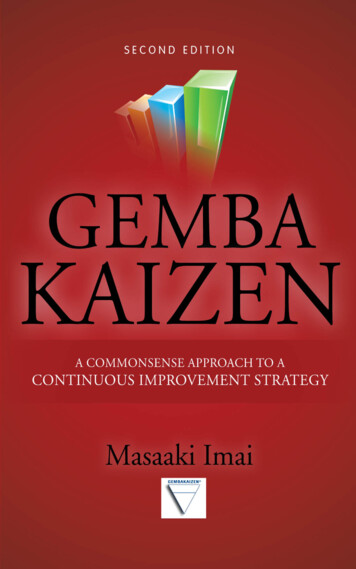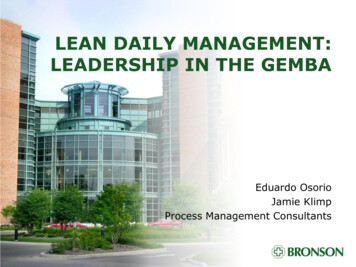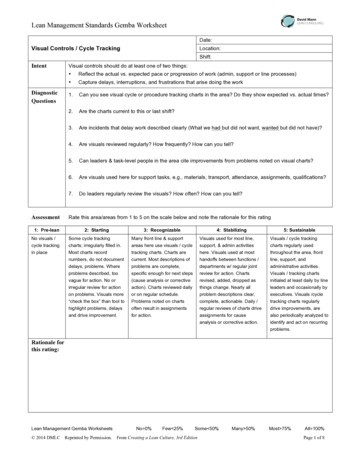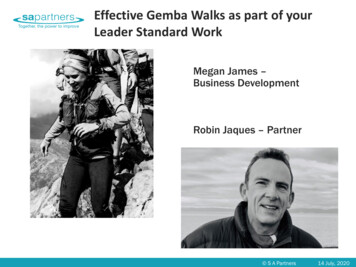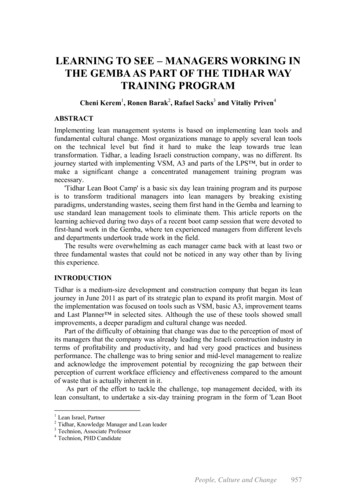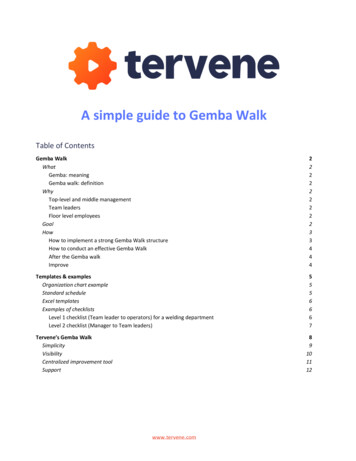
Transcription
A simple guide to Gemba WalkTable of ContentsGemba WalkWhatGemba: meaningGemba walk: definitionWhyTop-level and middle managementTeam leadersFloor level employeesGoalHowHow to implement a strong Gemba Walk structureHow to conduct an effective Gemba WalkAfter the Gemba walkImprove22222222233444Templates & examplesOrganization chart exampleStandard scheduleExcel templatesExamples of checklistsLevel 1 checklist (Team leader to operators) for a welding departmentLevel 2 checklist (Manager to Team leaders)5556667Tervene’s Gemba WalkSimplicityVisibilityCentralized improvement toolSupport89101112www.tervene.com
Gemba WalkWhatGemba: meaningGemba (also written “genba”): Japanese word meaning “the real place.” It’s where value creation happens, but alsowhere most problems occur.Gemba walk: definitionIn the manufacturing world, a Gemba walk is the action of walking around a factory floor, or any other department,to identify problems and improvement ideas.WhyThe Gemba walk is essential to sustain a company’s continuous improvement culture. It represents the first step in astructured process that aims to systematically identify improvement opportunities and transform these ideas intoimprovement plans. Here are just a few reasons to do it regularly:Top-level and middle managementIncrease productivity;Increase OEE (Overall Equipment Effectiveness);Reduce health and safety hazards;Increase team leaders, lower management and workers autonomy;Shift from reactive to proactive supervision.Team leadersIncrease credibility;Increase proactive supervision;Reduce time spent on reactive problem solving;Increase time spent on improvement projects;Mobilize team members;Simplify problem management.Floor level employeesDay to day problems are being seen, understood and solved;Increase implication in the improvement projects;Decrease waiting time;Decrease stress;Improve processes and tools;Increase feedback.GoalIdentify and solve issues before they have an impact.Identify and generate improvement opportunities.2www.tervene.com
HowHow to implement a strong Gemba Walk structure1.2.3.4.5.6.7.Organizational chartThe first step is to put the company’s organizational chart up to date to determine who oversees whatdepartment (and who). The best tool to do so is probably Visio from Microsoft, but Lucidchart can do the jobjust fine for free. It is critical to define clear roles and responsibilities at this stage.Introduction meetingThe top executive holds a meeting with all the team leaders, presenting the Gemba Walk and explaining whyit's useful for them. This step is vital to reduce resistance to change.Set-up Gemba Walk checklistsIn collaboration with each team leaders, create a list of verification points that they must validate with everywork units in their department every two hours. Always remember, these checklists must aim to identify andreduce waste. It is important that the workers know that the Team leaders are performing these GembaWalks to help them and find solutions, not to punish them.Standard scheduleSet-up a recurring 4 times per day event in the team leaders schedule so that they don't forget to do theirGemba walks. For level 2 management, a Gemba Walk should be performed twice per day. For a standardschedule example, have a look at page 5.Effective Gemba walk trainingShadow every team leaders' Gemba walk individually at least once a week to make sure they carry it out inthe right way. (See How to conduct a Gemba Walk for details)Schedule improvement meetingsAt least once a week, set a recurring meeting in the team leaders’ schedule to be carried out with the plantmanager. The goal of this meeting is to follow up on improvement plans that are in progress and create newones from the new improvement opportunities they found during the past week. Your team leaders mighttell you they don't have time, but they must understand they’ll save time by preventing problems throughGemba Walks rather than solving them after they happen.Sustain the GembaRemember, we are trying to achieve continuous improvement, which means these practices should becarried out every day. We strongly recommend setting goals for how many new improvement opportunitieseach team leaders should come up with every week. We recommend setting the goal to 2 new improvementopportunities per week per team leader.3www.tervene.com
How to conduct an effective Gemba WalkValidate all the points on the checklist with every work unit.Remember that those questions are asked to identify potential issues and improvement opportunities untilthe next Gemba Walk.Ask questions in a solution-oriented way rather than trying to find who’s at fault.Validate with the worker on every question by asking what, why and how. For example:Painting Gemba Walkchecklist questionIs the worker aware of all thework order information forthe current job?Follow up questionsooooooWhat is the colour code for the job?What is the quality standard for the job?How many pieces do you have to paint in that batch?How do you usually paint that kind of piece?Why do you do it like that?If you had to do it your way, how would you do it?Document an issue with the relevant information when you identify one.Write something next to the worker’s name only if there is a potential issue.An effective Gemba Walk should not take more than 15 minutes ( 1min/work unit).Wait before the Gemba Walk has been completed to address issues. Assessing all the work units in yourdepartment before taking action ensures an excellent prioritization.After the Gemba walk1. Make a quick evaluation of the risk and the impact of every potential issue and then compare them to each2.3.4.5.other.Prioritize the issues in the order in which you think they should be solved.Solve the issues in the order you just chose.Once these potential issues are solved and you made sure everything is under control until the next GembaWalk, look for improvement opportunities in the issues you brought up in the Gemba Walk. Every issue thatcould be prevented by standardizing procedures, implementing a 5S, a Kanban system, conducting a SMED,buying new equipment or tools, etc. qualifies as an improvement opportunity.Use a system to list all your improvement opportunities, preferably linking the following information to it:o Team leader nameo Work stationo Checklist point that made you come up with the ideao Internal impacts Eg. Operation cost, lead time, productivity, quality, leadership, process, internalcommunications, health and safety, etc.o Customer impacts Eg. Financial, delivery time, quality, customer service, etc.o Other work center impactedo Date and timeImproveOnce a week, the plant manager or the operation manager should conduct an improvement meeting with allthe team leaders.The improvement meeting’s objective is to ensure a follow up on the improvement plans already in place andto put new ones in place if the team leaders’ schedule allows it.4www.tervene.com
Templates & examplesOrganization chart exampleIt’s essential to thoroughly define in the organization chart who controls what department to make sure the GembaWalks are being performed on the right work units by the right managers.Standard scheduleHaving a standard schedule is key to improve performance. A worker that knows their supervisor’s schedule will waituntil then to ask questions or make requests, consequently saving time for both the employee and his supervisor. Werecommend scheduling the Level 2 Gemba Walk right after the second Level 1 Gemba Walk. This way, the informationfrom the two previous Level 1 Gemba Walks can be shared with the production manager.Level 1 (team leader)Level 2 (production manager)5www.tervene.com
Excel templatesHere is a link to download excel templates for Gemba Walk: TemplatesExamples of checklistsLevel 1 checklist (Team leader to operators) for a welding departmentThe goal is to identify two main categories of problems:1. Issues that occurred in the past: to help generate new questions in the checklist to prevent those problemsfrom happening again.2. Issues that might happen soon: to prevent them from happening and create proactive measures to minimizethe risk of it coming sEquipmentMaterialChecklist examplesHas there been any problems related to required tools, material, personnel orinformation in the past two hours that we didn't see coming?Has there been any problems related to quality in the past two hours that we didn'tsee coming?Has there been any problems related to productivity in the past two hours that wedidn't see coming?Is the worker at his workstation?Is the worker punched on the right job?Is the worker aware of all the information on the work order for the current job?Does the work order provide all the needed specifications?Does the worker know the procedures and standards for the current job?Does the worker have the proper training for the current job?Does the employee have all the necessary tools for the current job?Are the tools in good working order?Is the 5S respected?Is the equipment working well? Does it need maintenance?Does the worker have all the required material for the current job?Is the worker aware of the quality standards for the current job?Are quality standards respected?Is the quality rate goal known and respected?Are Health and Safety standards respected?Does the production rate follow the schedule?Is the takt time respected?Does the worker know the next priority?Is the worker aware of all the information on the work order for the next job?Does the worker have all the required material for the next job?Does the worker know the procedures and standards for the next job?Does the employee have the proper training for the next job?Does the employee have all the required tools for the next job?Will the parts will be ready and available at the right time?Again, we suggest keeping the Level 1 Gemba Walk under 15 minutes and to perform it at least every two hours. Ifthere are too many questions in the checklist, team leaders won’t identify more problems, but rather let them slip.Keep it short, but effective. Think 80/20 (Pareto Principle).6www.tervene.com
Level 2 checklist (Manager to Team leaders)Team leaders don’t always have the power, the authority or the time to address the issues they stumble onto.Therefore, it’s important for the manager to perform regular and scheduled (although less frequent) Gemba Walksafter the team leaders’ to share information. We recommend performing a level 2 Gemba Walk for every two Level 1Gemba Walks performed by the team tionInformationChecklist examplesHas there been any problems related to required tools, material,personnel or information in the past two hours that we didn't seecoming?Has there been any problems related to quality in the past two hoursthat we didn't see coming?Has there been any problems related to productivity in the past twohours that we didn't see coming?Could we reduce waste?Are there any issues to transfer?Did the team leader perform his two Gemba Walks?Is the team leader aware of the priorities?Is the equipment working well? Does it need maintenance?Does the department all the necessary material for the current job?Are quality standards respected?Is the quality rate goal known and respected?Are Health and Safety standards respected?Does the production rate follow the schedule?Is the takt time respected?Does the department need more people for the next job?Are there any other issues to talk about?7www.tervene.com
Tervene’s Gemba WalkWhile it can seem easy to perform Gemba Walks, it can become a struggle to develop the right system to documentand manage Gemba Walk reports as well as to compile the data. It is also important to mention that the main challengepeople come across when trying to implement a continuous improvement culture involving Gemba Walks is to sustainthe project over time. The culprit: Change Resistance to inefficient and unnatural management behaviours.Technology will never perform the Gemba Walk for you, but itcan at least remove most of the hassle for the user. It canfacilitate the documentation, evaluation and management ofthe information and the reports.Here are a few reasons why you might want to considerperforming your Gemba Walks with Tervene’s Software:SimplicityVisibilityCentralized improvement toolSupport8www.tervene.com
SimplicityHere’s how Tervene’s solution can help you manage your Gemba Walks.From the Ipad app, carry out your scheduled,standardized Gemba Walks and systematically reportpotential issues.At the end of the Gemba Walk, the observations youenter automatically generate a report. If the issue can besolved indefinitely, press thebutton. The issue clearsitself from the report and is now archived in thecompany’s statistics.If an improvement project is needed to prevent theissue from occurring again, press thebuttonto convert it into an improvementopportunity.From there, you can report internal or customerimpacts, as well as which other work centers areimpacted.9www.tervene.com
VisibilityOne of the great advantages of using Tervene to perform Gemba Walks is the visibility it offers over the supervisionactivities that take place in the workplace. We’ve found that commitment and regular follow-up from leadership isthe single most important predictor of success in the implementation of a continuous improvement culture.From the many dashboards included in the web interface, higher management can keeptrack of key indicators:Number of Gemba Walks carried out.Number of issues identified.Number of issues by category.Details on every issue found.
Gemba (also written “genba”): Japanese word meaning “the real place.” It’s where value creation happens, but also where most problems occur. Gemba walk: definition In the manufacturing world, a Gemba walk is the action of walking around a factory floor, or any other department, to identify problems and improvement ideas. Why The Gemba walk is essential to sustain a company’s .File Size: 1MBPage Count: 12
